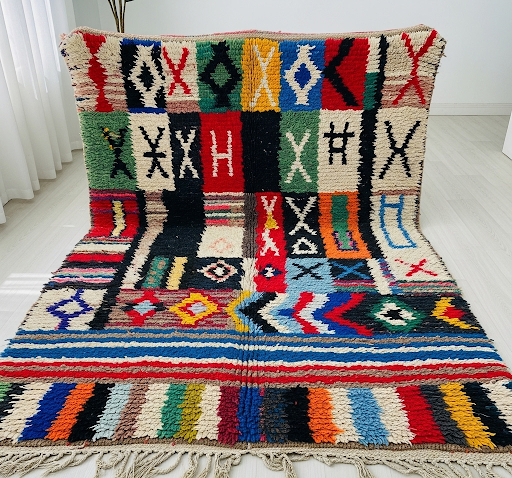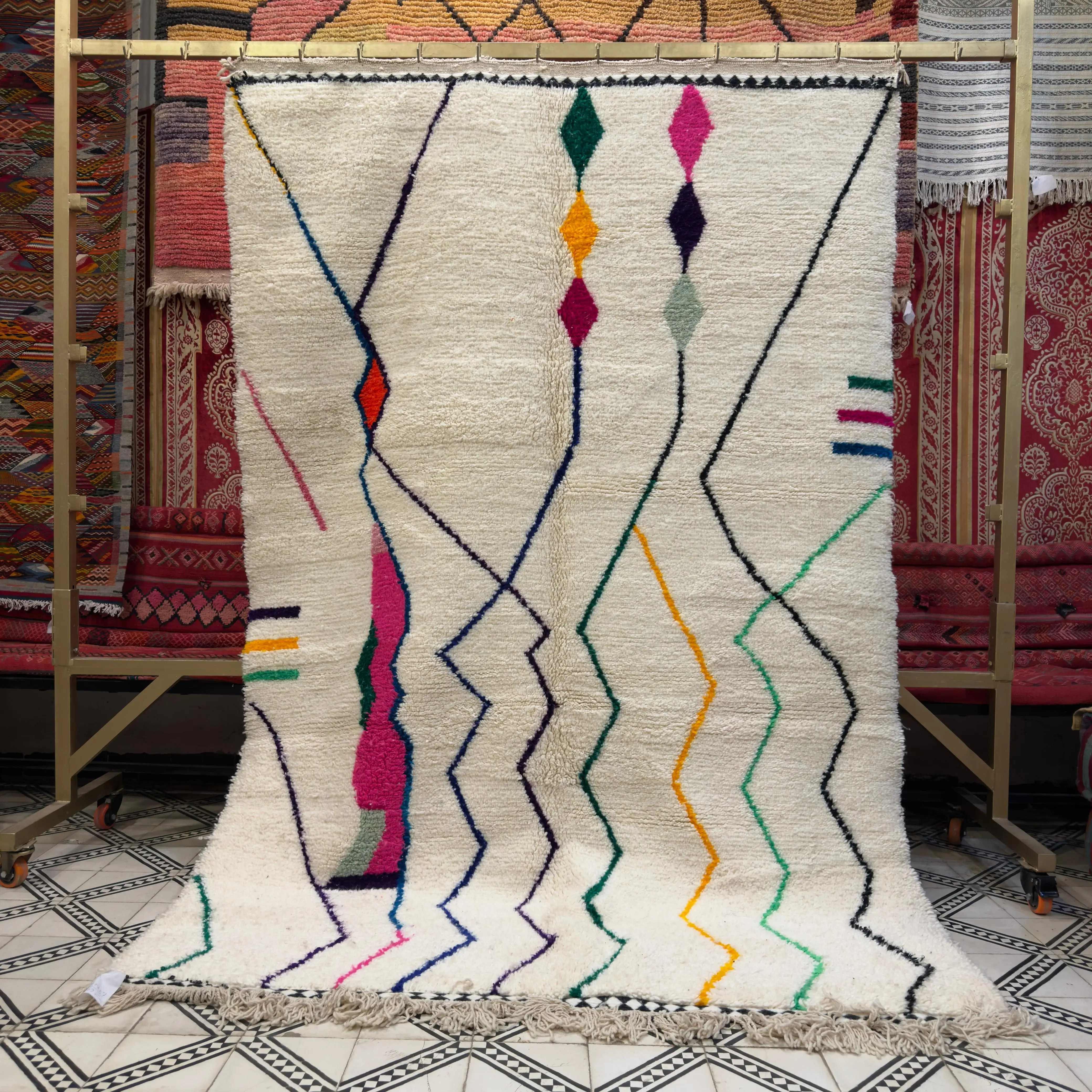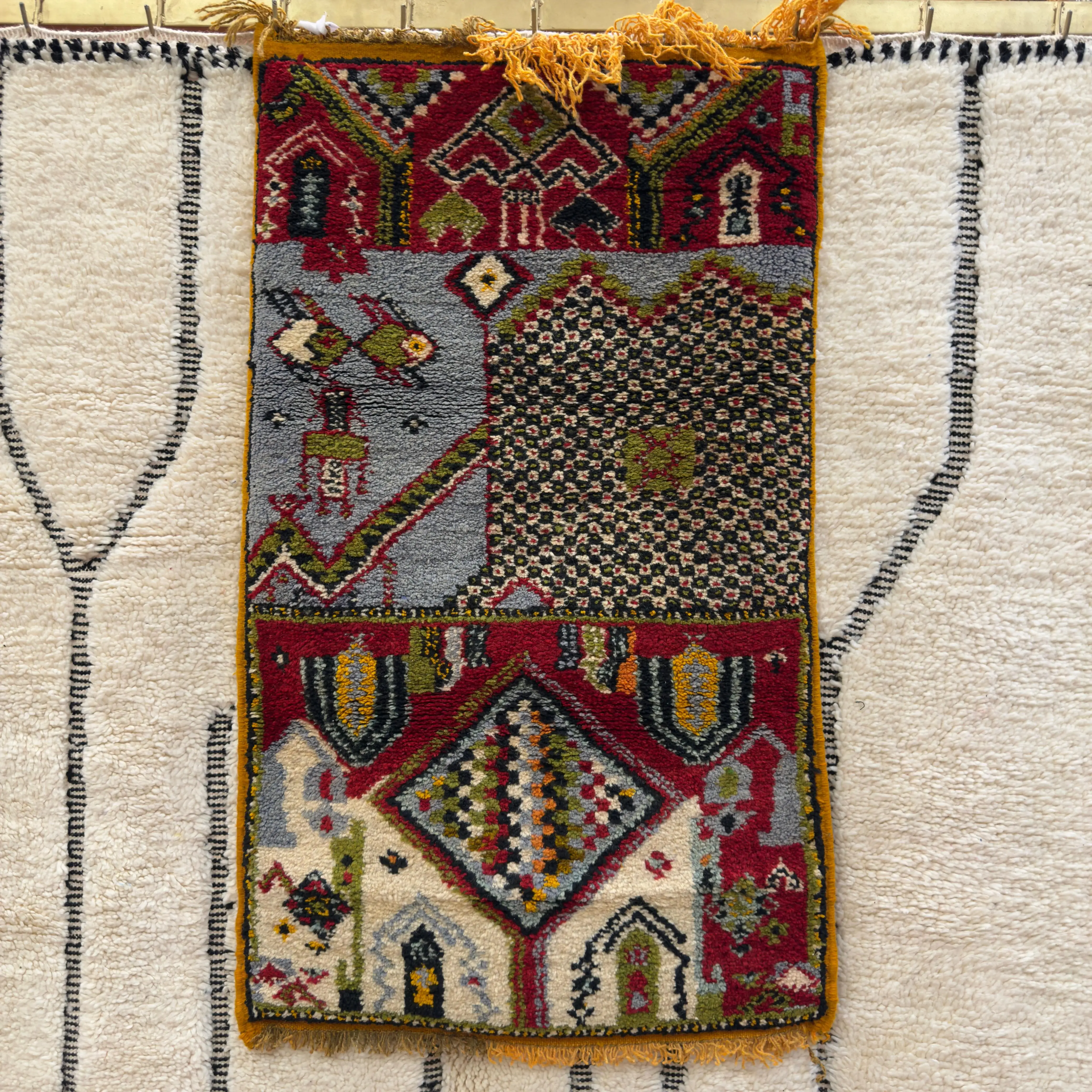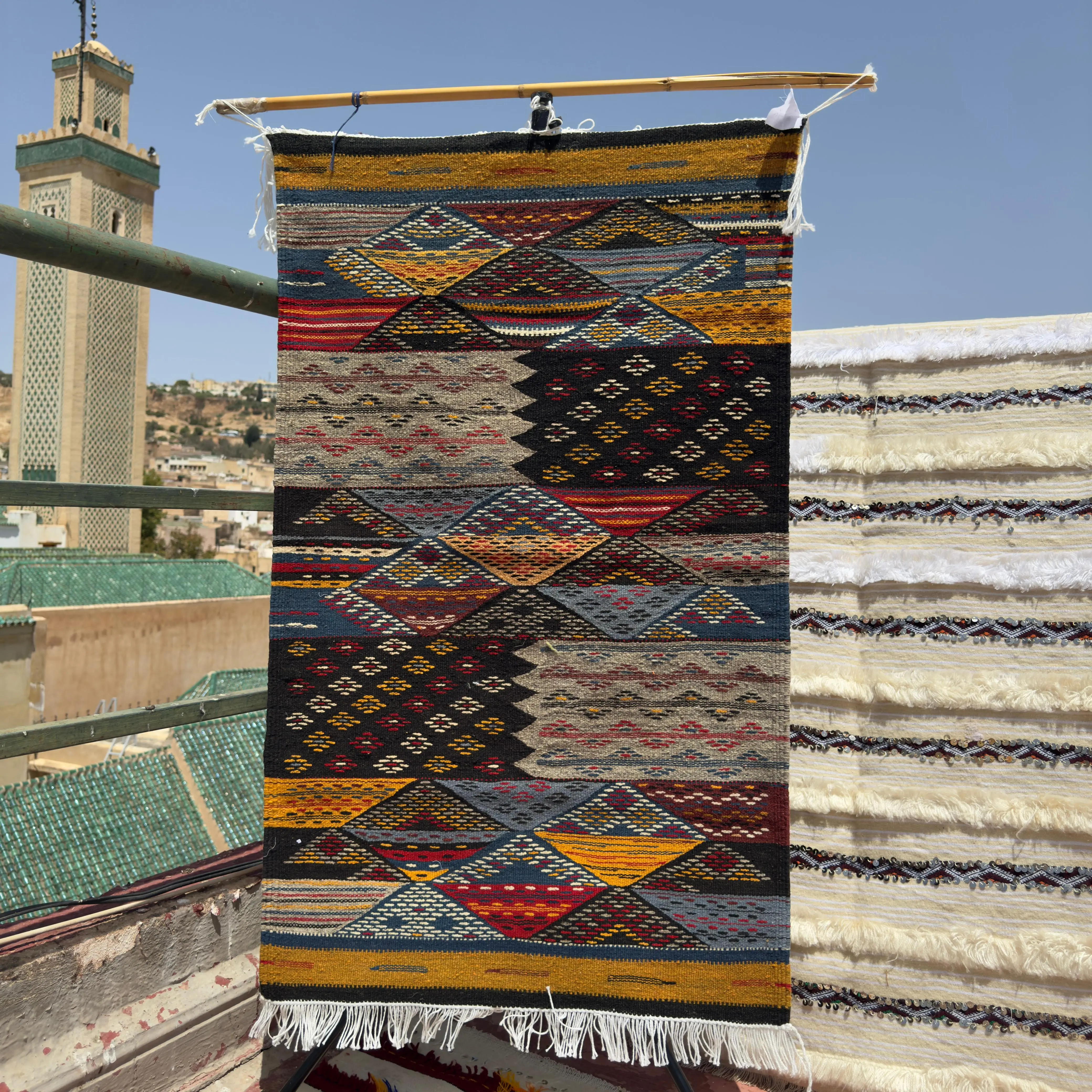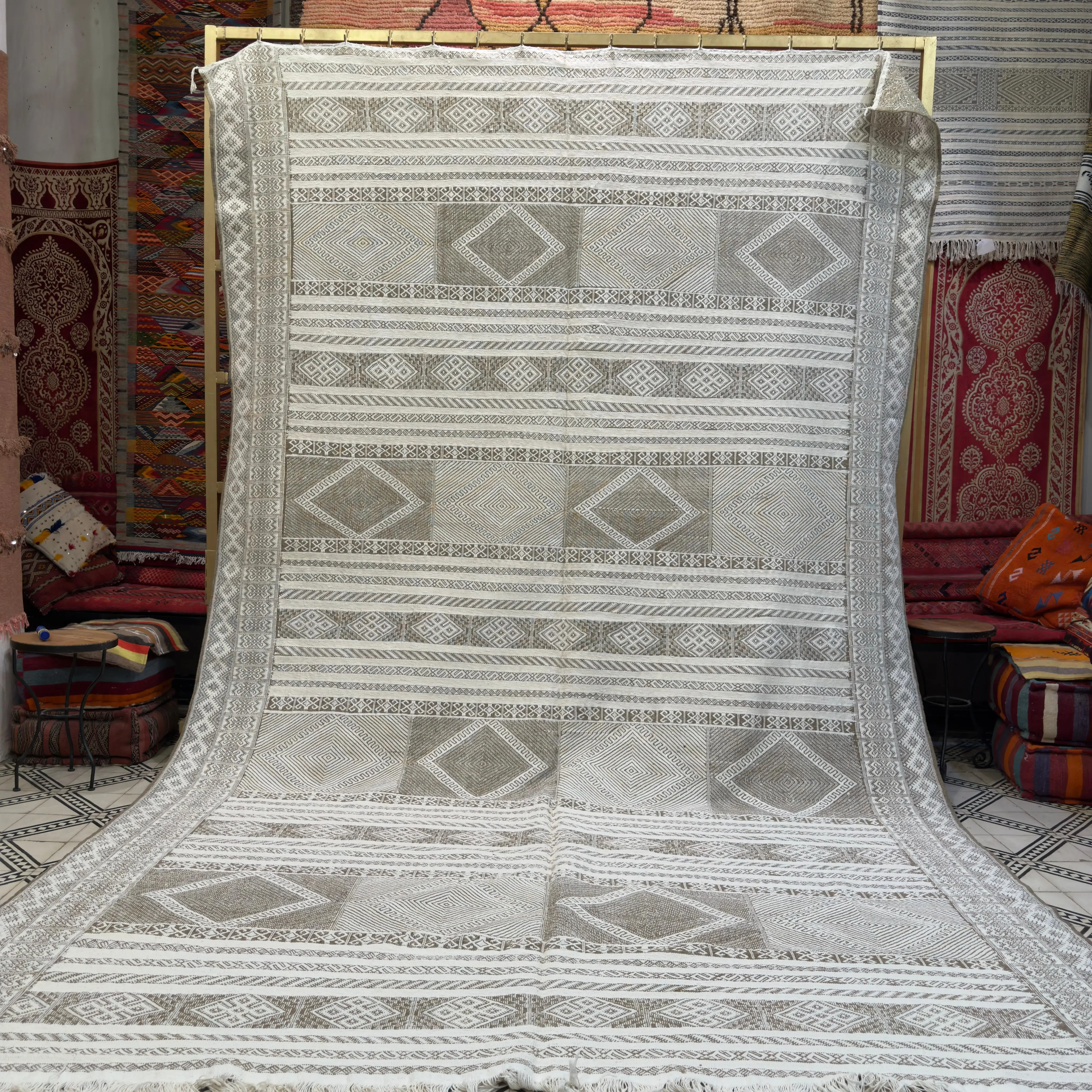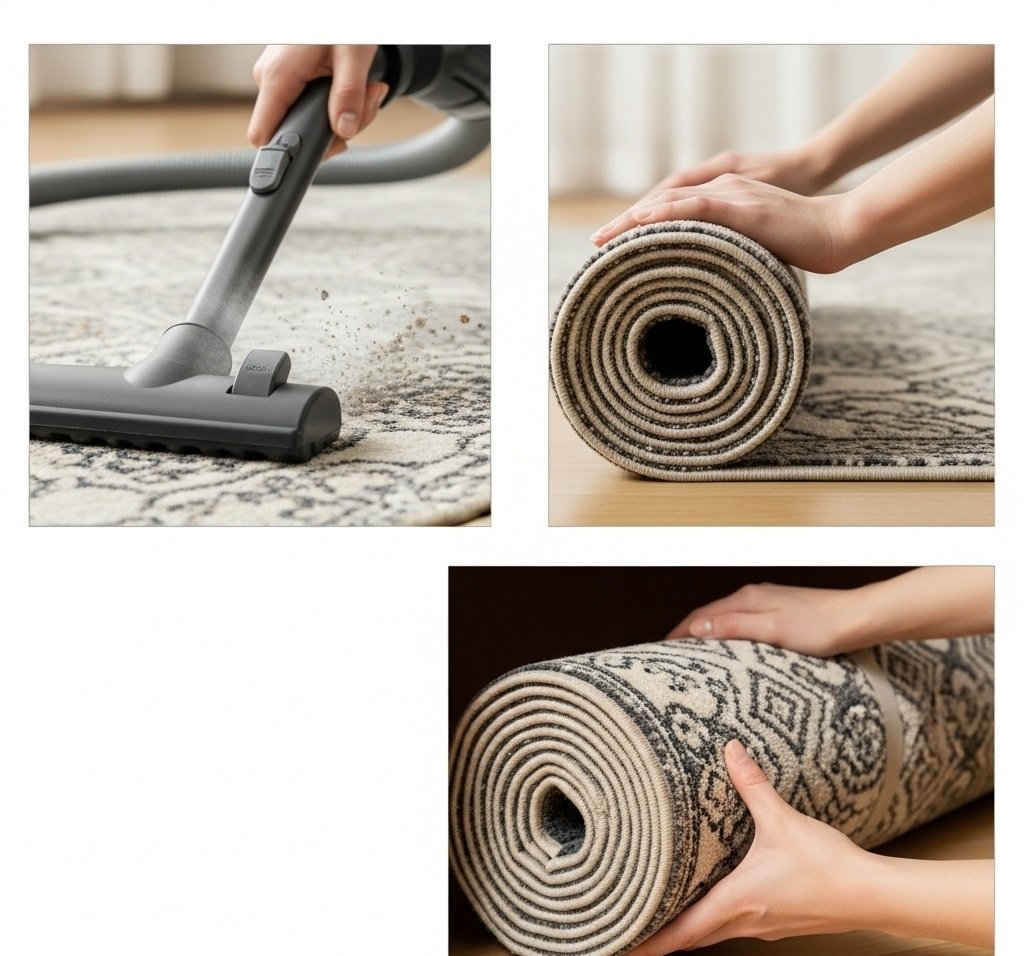
02 Aug 2025
Guide to Choosing and Styling
An area rug is an investment. It's a piece of art for your floor, a source of comfort, and the anchor of your room's design. Whether you're swapping out rugs for the season, preparing for a move, or simply storing a beloved piece, how you put it away is just as important as how you care for it day-to-day. Improper storage can lead to permanent damage, turning a treasured heirloom into a creased, moth-eaten tragedy.
Don't let your beautiful rug suffer in silence. This is the preservationist's guide to doing it right, covering the essential steps of cleaning, rolling, and storing to ensure your rug emerges from its hibernation as beautiful as the day you put it away.

Step 1: The Deep Clean - A Non-Negotiable First Step
This is the most critical rule of rug storage: never store a dirty rug. Rolling up a rug with even a small amount of dirt, dust, or food crumbs is an open invitation for pests like moths and carpet beetles. Stains can set permanently over time, and dirt particles can act like sandpaper, slowly breaking down the rug's delicate fibers while it's in storage.
While regular vacuuming is great for maintenance, it's not enough for a pre-storage clean. To ensure all the deep-seated grime and invisible allergens are gone, you need professional area rug cleaning. This is especially true for large area rugs that are impossible to clean thoroughly at home. A professional service has the proper tools and solutions to wash the rug safely and ensure it is completely dry before storage, preventing any risk of mold or mildew.
Step 2: The Art of the Roll - Why You Should Never Fold
Folding a rug is a cardinal sin in the world of textile preservation. It creates hard creases that can permanently break the rug's foundational threads (the warp and weft), leading to cracks and irreparable damage. The only way to store a rug is to roll it.
How to Roll Like a Pro:
-
Determine the Pile Direction: Lay the rug flat, pile-side up. Run your hand across the surface. One direction will feel smooth, and the other will feel rough. You want to roll the rug against the smooth direction (against the grain). This protects the pile from being crushed.
-
Roll Tightly and Straight: Start at the end you've chosen and begin rolling the rug as tightly and straight as you can. For a standard 8x10 area rug or larger, this is much easier with two people. A straight, tight roll prevents buckling and creasing.
Step 3: Wrap It Right for Ultimate Protection
Once your rug is rolled, you need to protect it from dust, moisture, and pests. Your first instinct might be to wrap it in plastic, but that's a mistake. Standard plastic wrap can trap moisture, creating a breeding ground for mold and mildew.
The Best Wrapping Materials:
-
Muslin or Cotton Sheets: An old, clean cotton sheet is a great breathable option.
-
Tyvek Wrap: This is what professional rug storers and museums use. It's a durable, breathable, water-resistant material that offers superior protection.
Wrap the rug completely and secure the covering with twine or fabric strips. Tie them snugly, but not so tightly that they leave marks on the rug.
Step 4: The Perfect Storage Spot
Where you store your rug is just as important as how you prepare it. The ideal environment is cool, dry, and dark, with minimal fluctuations in temperature and humidity.
-
Avoid Attics and Basements: These areas are prone to extreme temperature shifts and high humidity, which can damage fibers and encourage mildew.
-
The Best Locations: A climate-controlled storage unit is the gold standard. If that's not an option, the back of a closet or under a bed (as long as it's completely dry) are good alternatives.
-
Positioning is Key: The best way to store a rolled rug is horizontally on a flat, elevated surface that keeps it off the floor. If you must store it vertically, make sure it's standing straight up on its end and not leaning at an angle, which could cause it to bend and lose its shape over time.
Conclusion: Preserve Your Investment
Properly storing your area rug is a simple process that pays huge dividends. By following these four steps—Clean, Roll, Wrap, and Store—you are taking the necessary precautions to protect your investment. Whether it's one of your large area rugs or a smaller accent piece, a little care ensures that it will continue to bring beauty and comfort to your home for many years to come.
Un tapis est un investissement. C'est une œuvre d'art pour votre sol, une source de confort et l'ancre du design de votre pièce. Que vous changiez de tapis pour la saison, que vous prépariez un déménagement ou que vous rangiez simplement une pièce que vous aimez, la façon dont vous le rangez est tout aussi importante que la façon dont vous en prenez soin au quotidien. Un rangement inapproprié peut entraîner des dommages permanents, transformant un héritage précieux en une tragédie froissée et mangée par les mites.
Ne laissez pas votre magnifique tapis souffrir en silence. Ceci est le guide du conservateur pour bien faire les choses, couvrant les étapes essentielles du nettoyage, du roulage et du rangement pour que votre tapis sorte de son hibernation aussi beau que le jour où vous l'avez rangé.

Étape 1 : Le nettoyage en profondeur - Une première étape non négociable
C'est la règle la plus critique du rangement des tapis : ne jamais ranger un tapis sale. Enrouler un tapis avec même une petite quantité de saleté, de poussière ou de miettes de nourriture est une invitation ouverte pour les parasites comme les mites et les anthrènes des tapis. Les taches peuvent se fixer de façon permanente avec le temps, et les particules de saleté peuvent agir comme du papier de verre, décomposant lentement les fibres délicates du tapis pendant qu'il est rangé.
Bien que l'aspiration régulière soit excellente pour l'entretien, elle n'est pas suffisante pour un nettoyage avant le rangement. Pour s'assurer que toute la saleté incrustée et les allergènes invisibles ont disparu, vous avez besoin d'un nettoyage de tapis professionnel. C'est particulièrement vrai pour les grands tapis qui sont impossibles à nettoyer à fond à la maison. Un service professionnel dispose des outils et des solutions appropriés pour laver le tapis en toute sécurité et s'assurer qu'il est complètement sec avant le rangement, prévenant ainsi tout risque de moisissure.
Étape 2 : L'art de rouler - Pourquoi il ne faut jamais plier
Plier un tapis est un péché capital dans le monde de la conservation des textiles. Cela crée des plis durs qui peuvent casser de façon permanente les fils de fondation du tapis (la chaîne et la trame), entraînant des fissures et des dommages irréparables. La seule façon de ranger un tapis est de le rouler.
Comment rouler comme un pro :
-
Déterminez la direction du poil : Posez le tapis à plat, le poil vers le haut. Passez votre main sur la surface. Une direction sera lisse, et l'autre sera rugueuse. Vous voulez rouler le tapis contre la direction lisse (à contre-poil). Cela protège le poil d'être écrasé.
-
Roulez serré et droit : Commencez à l'extrémité que vous avez choisie et commencez à rouler le tapis aussi serré et droit que possible. Pour un tapis de 8x10 standard ou plus grand, c'est beaucoup plus facile à deux. Un rouleau droit et serré empêche le gondolement et les plis.
Étape 3 : Emballez-le correctement pour une protection ultime
Une fois votre tapis enroulé, vous devez le protéger de la poussière, de l'humidité et des parasites. Votre premier instinct pourrait être de l'emballer dans du plastique, mais c'est une erreur. L'emballage plastique standard peut emprisonner l'humidité, créant un terrain propice à la moisissure.
Les meilleurs matériaux d'emballage :
-
Mousseline ou draps en coton : Un vieux drap en coton propre est une excellente option respirante.
-
Emballage Tyvek : C'est ce que les professionnels du rangement de tapis et les musées utilisent. C'est un matériau durable, respirant et résistant à l'eau qui offre une protection supérieure.
Emballez complètement le tapis et fixez la couverture avec de la ficelle ou des bandes de tissu. Attachez-les fermement, mais pas au point de laisser des marques sur le tapis.
Étape 4 : L'endroit de rangement parfait
L'endroit où vous rangez votre tapis est tout aussi important que la façon dont vous le préparez. L'environnement idéal est frais, sec et sombre, avec des fluctuations minimales de température et d'humidité.
-
Évitez les greniers et les sous-sols : Ces zones sont sujettes à des changements de température extrêmes et à une forte humidité, ce qui peut endommager les fibres et favoriser la moisissure.
-
Les meilleurs emplacements : Une unité de stockage climatisée est la référence absolue. Si ce n'est pas une option, le fond d'un placard ou sous un lit (tant qu'il est complètement sec) sont de bonnes alternatives.
-
Le positionnement est la clé : La meilleure façon de ranger un tapis enroulé est horizontalement sur une surface plane et surélevée qui le maintient hors du sol. Si vous devez le ranger verticalement, assurez-vous qu'il est debout bien droit sur son extrémité et non penché, ce qui pourrait le faire plier et perdre sa forme avec le temps.
Conclusion : Préservez votre investissement
Ranger correctement votre tapis est un processus simple qui rapporte d'énormes dividendes. En suivant ces quatre étapes — Nettoyer, Rouler, Emballer et Ranger — vous prenez les précautions nécessaires pour protéger votre investissement. Qu'il s'agisse de l'un de vos grands tapis ou d'une pièce d'appoint plus petite, un peu de soin garantit qu'il continuera à apporter beauté et confort à votre maison pendant de nombreuses années.
Una alfombra es una inversión. Es una obra de arte para tu suelo, una fuente de confort y el ancla del diseño de tu habitación. Ya sea que estés cambiando de alfombra por la temporada, preparándote para una mudanza o simplemente guardando una pieza querida, la forma en que la guardas es tan importante como la forma en que la cuidas en el día a día. Un almacenamiento inadecuado puede provocar daños permanentes, convirtiendo una reliquia preciada en una tragedia arrugada y apolillada.
No dejes que tu magnífica alfombra sufra en silencio. Esta es la guía del conservador para hacerlo bien, cubriendo los pasos esenciales de limpieza, enrollado y almacenamiento para asegurar que tu alfombra salga de su hibernación tan hermosa como el día que la guardaste.

Paso 1: La limpieza a fondo - Un primer paso no negociable
Esta es la regla más crítica del almacenamiento de alfombras: nunca guardes una alfombra sucia. Enrollar una alfombra con incluso una pequeña cantidad de suciedad, polvo o migas de comida es una invitación abierta para plagas como polillas y escarabajos de las alfombras. Las manchas pueden fijarse permanentemente con el tiempo, y las partículas de suciedad pueden actuar como papel de lija, descomponiendo lentamente las delicadas fibras de la alfombra mientras está almacenada.
Aunque la aspiración regular es excelente para el mantenimiento, no es suficiente para una limpieza antes del almacenamiento. Para asegurarte de que toda la suciedad incrustada y los alérgenos invisibles se han ido, necesitas una limpieza de alfombras profesional. Esto es especialmente cierto para las grandes alfombras que son imposibles de limpiar a fondo en casa. Un servicio profesional tiene las herramientas y soluciones adecuadas para lavar la alfombra de forma segura y asegurarse de que esté completamente seca antes de guardarla, previniendo así cualquier riesgo de moho.
Paso 2: El arte de enrollar - Por qué nunca debes doblar
Doblar una alfombra es un pecado capital en el mundo de la conservación de textiles. Crea pliegues duros que pueden romper permanentemente los hilos de la base de la alfombra (la urdimbre y la trama), provocando grietas y daños irreparables. La única forma de guardar una alfombra es enrollarla.
Cómo enrollar como un profesional:
-
Determina la dirección del pelo: Coloca la alfombra en plano, con el pelo hacia arriba. Pasa la mano por la superficie. Una dirección se sentirá suave y la otra áspera. Debes enrollar la alfombra en contra de la dirección suave (a contrapelo). Esto protege el pelo de ser aplastado.
-
Enrolla apretado y recto: Comienza por el extremo que has elegido y empieza a enrollar la alfombra lo más apretado y recto que puedas. Para una alfombra de 8x10 estándar o más grande, es mucho más fácil con dos personas. Un rollo recto y apretado evita que se abombe y se arrugue.
Paso 3: Envuélvela correctamente para una protección máxima
Una vez que tu alfombra está enrollada, debes protegerla del polvo, la humedad y las plagas. Tu primer instinto podría ser envolverla en plástico, pero eso es un error. El envoltorio de plástico estándar puede atrapar la humedad, creando un caldo de cultivo para el moho.
Los mejores materiales de embalaje:
-
Muselina o sábanas de algodón: Una sábana de algodón vieja y limpia es una excelente opción transpirable.
-
Envoltura de Tyvek: Esto es lo que utilizan los profesionales del almacenamiento de alfombras y los museos. Es un material duradero, transpirable y resistente al agua que ofrece una protección superior.
Envuelve la alfombra por completo y asegura la cubierta con cordel o tiras de tela. Átalos firmemente, pero no tanto como para dejar marcas en la alfombra.
Paso 4: El lugar de almacenamiento perfecto
El lugar donde guardas tu alfombra es tan importante como la forma en que la preparas. El entorno ideal es fresco, seco y oscuro, con fluctuaciones mínimas de temperatura y humedad.
-
Evita los áticos y los sótanos: Estas áreas son propensas a cambios extremos de temperatura y alta humedad, lo que puede dañar las fibras y favorecer la aparición de moho.
-
Los mejores lugares: Una unidad de almacenamiento climatizada es el estándar de oro. Si no es una opción, la parte trasera de un armario o debajo de una cama (siempre que esté completamente seco) son buenas alternativas.
-
La posición es clave: La mejor manera de guardar una alfombra enrollada es horizontalmente sobre una superficie plana y elevada que la mantenga alejada del suelo. Si debes guardarla verticalmente, asegúrate de que esté de pie completamente recta sobre su extremo y no inclinada, lo que podría hacer que se doble y pierda su forma con el tiempo.
Conclusión: Preserva tu inversión
Guardar correctamente tu alfombra es un proceso sencillo que reporta enormes beneficios. Siguiendo estos cuatro pasos —Limpiar, Enrollar, Envolver y Guardar— estás tomando las precauciones necesarias para proteger tu inversión. Ya sea una de tus grandes alfombras o una pieza de acento más pequeña, un poco de cuidado asegura que seguirá aportando belleza y comodidad a tu hogar durante muchos años.




